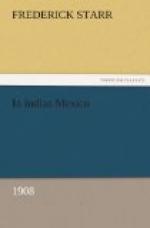While arrangements were being made for showing us these details regarding paper-making, we visited the village church, which was very mean and bare; we were disappointed to find nothing suspicious in the way of munecos. It was suggested that we should visit the oratorio, where we found more. Here they held their costumbre in June, or thereabouts. Saints were arranged in the back of the room on a raised altar; in front of this, running through the middle of the room, was a table on which stood censers and small candle-sticks of rude pottery. Upon the wall, over the saints, were decorations of rushes. Here the whole village feast and dance. There were no munecos present, but we found plenty of cut paper, most of which was probably decorative; the most curious was cut into groups of human figures, some of which had crowns and horns, or tufts of hair, upon the top of their heads. These were said to be decorations for Montezuma, in whose honor the feast was given. Leaving San Pablo at eleven, we rapidly made what remained of the great ascent. As we neared the jagged crest of rock, it appeared more irregularly gashed and pinnacled than ever. At the crest, leaving the old road, which passed directly through the fantastic mass of rocks, we reached San Nicolas, from which, on looking backward, we gained a magnificent view of the valley and a fine waterfall, which shone like a sheet of polished metal, far up the mountain side. From here our road descended gently, but winding, in and out, through a series of narrow valleys, lying between parallel ridges. As we passed the crest, we saw a level field of green corn, which looked as if we must reach it in a few minutes. But the curves of the road proved frightfully long. It was after two o’clock before we reached the green field, and, just below it, Tenango del Doria, and made our way to the jefatura.




